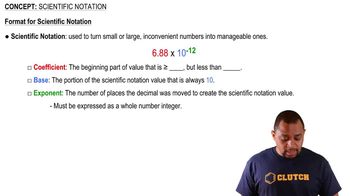The following statements pertain to the development of the theory of the structure of DNA. Match the statement with the appropriate step (observation, hypothesis, experiment designed to test hypothesis) in the scientific method. (b) In a sample of DNA, there are equal amounts of the bases A and T and equal amounts of the bases C and G.
Ch.1 - Chemical Tools: Experimentation & Measurement
Chapter 1, Problem 36
Refer to Figure 1.2. What is developed when numerous observations support a hypothes
 Verified step by step guidance
Verified step by step guidance1
Identify the key terms in the problem: 'observations', 'support', and 'hypothesis'.
Understand that in scientific methodology, a hypothesis is a proposed explanation for a phenomenon.
Recognize that when numerous observations consistently support a hypothesis, it can lead to the development of a scientific theory.
A scientific theory is a well-substantiated explanation of some aspect of the natural world, based on a body of evidence.
The process involves repeated testing and validation of the hypothesis through experiments and observations.

Verified video answer for a similar problem:
This video solution was recommended by our tutors as helpful for the problem above.
Video duration:
1mWas this helpful?
Key Concepts
Here are the essential concepts you must grasp in order to answer the question correctly.
Hypothesis
A hypothesis is a testable statement or prediction about the relationship between two or more variables. It is formulated based on prior knowledge, observations, or theories and serves as a starting point for scientific investigation. A well-structured hypothesis can be supported or refuted through experimentation and observation.
Scientific Theory
A scientific theory is a well-substantiated explanation of some aspect of the natural world that is based on a body of evidence and has withstood repeated testing and scrutiny. Unlike a hypothesis, which is a preliminary idea, a theory is developed when numerous observations and experiments consistently support a particular explanation, making it widely accepted within the scientific community.
Recommended video:
Guided course

Scientific Notation Concepts
Empirical Evidence
Empirical evidence refers to information acquired by observation or experimentation that can be verified and is used to support or refute a hypothesis or theory. This type of evidence is crucial in the scientific method, as it provides the data needed to draw conclusions and develop theories based on real-world phenomena rather than speculation.
Recommended video:
Guided course

Empirical vs Molecular Formula
Related Practice
Textbook Question
51
views
Textbook Question
The following statements pertain to the development of the theory of the structure of DNA. Match the statement with the appropriate step (observation, hypothesis, experiment designed to test hypothesis) in the scientific method. (c) Direct X rays at a sample of crystallized DNA, and inter-pret the diffraction pattern for structural information.
40
views
Textbook Question
Label the following statements about the world's largest gold bar as quantitative or qualitative observations. (This gold bar was worth approximately $10.25 million in 2013.) (a) The melting point of gold is 1064.2 °C. (b) The volume of the gold bar is 15,730 cm3. (c) Gold metal is a conductor of electricity. (d) The mass of the gold bar is 250 kg. (e) The gold bar is yellow and shiny
36
views
2
rank
Textbook Question
What is the difference between a hypothesis and theory? (a) A hypothesis provides an explanation for a phenomenon, but a theory does not.(b) A theory provides an explanation for a phenomenon, but a hypothesis does not.(c) Both a theory and a hypothesis provide an explanation for a phenomenon, but a theory has been upheld by experi-mental observations
56
views
1
rank
Textbook Question
What SI units are used for measuring the following quanti-ties? For derived units, express your answers in terms of the six fundamental units. (a) Mass
5
views
Textbook Question
What SI units are used for measuring the following quanti-ties? For derived units, express your answers in terms of the six fundamental units. (b) Length
5
views
